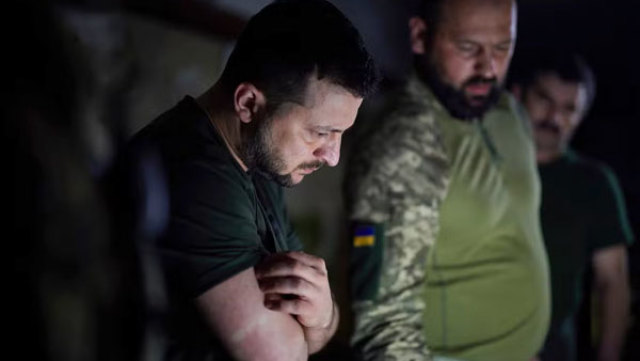On Sunday evening, five regions of Ukraine faced a blackout at once. And although electricity supply was restored after midnight in most areas, one of the largest thermal power plants in Ukraine – Kharkiv – was put out of operation for a long time. What could have caused a large-scale blackout, could it happen again and how could the collapses of the Ukrainian power grids affect the course of the special operation?On the eve of the President of Ukraine Vladimir Zelensky confirmed the information about the power outage in a number of regions of the country.
According to him, a complete power outage occurred in the Kharkiv and Donetsk regions, partial – in the Zaporozhye, Dnepropetrovsk and Sumy regions.
As reported by the Ukrainian edition of Vesti, power outages or interruptions in its supply on Sunday evening were recorded in the Kharkiv, Poltava, Dnipropetrovsk, Sumy and Odessa regions of Ukraine. At the same time, it is clarified that there was no electricity in some cities, and voltage surges were observed in others. A number of local authorities have confirmed blackouts and power outages.
"At about 19.00 Moscow time, there were reports of launches of "Calibers" from the Black and Caspian Seas. Cruise missiles hit the thermal power plant near Kharkov and Kremenchuk, but perhaps there were even more targets. This led to power outages in Kharkiv, Sumy, Dnipropetrovsk, Poltava, Zaporozhye and Odessa regions. Part of the regions [of Ukraine] were left without electricity, there is no communication and Internet, train traffic has been canceled," the Frontline news agency ANNA–News reported in its Telegram channel.
"As a result of night strikes on power generation facilities, two thermal power plants were severely damaged, which caused a crisis of energy supply in a number of regions of Ukraine," military commander Yuriy Kotenok reports in his Telegram channel. "According to preliminary data, Kharkiv CHPP-5 and Kremenchug CHPP were hit," he said. The channel also published video footage of the consequences of the strike on the Kharkiv CHP-5, specifying that the office of Vladimir Zelensky "confirms the hit of two missiles." "With a systemic impact on the energy system, the Russian Federation is quite able to achieve an energy collapse in Ukraine," the Kitten believes.
According to the Telegram channel TOGARMA, most of Ukraine's energy infrastructure is located in the south-east of the country. According to his data, on Sunday, "the Armed Forces of the Russian Federation hit key thermal power plants in the northeast [of Ukraine] and thereby de-energized several northern and eastern regions of Ukraine. The power system of Ukraine failed and hence the news that due to the imbalance of the power system, the South Ukrainian and Khmelnitsky nuclear power plants are disconnecting blocks from the grid."
At the same time, after midnight in most of the eastern regions of Ukraine, the situation with electricity supply was stabilized. At the same time, over the past three weeks, the number of attacks by Ukrainian militants on the critical infrastructure of the DPR has increased. Especially goes to the energy sector. During this week alone, enemy shells hit 983 substations. As a result, 63 thousand subscribers remained without electricity. Most often this happens in Gorlovka, Donetsk, Yasinovataya.
Since September 1, the territory of the Zaporozhye NPP and the city of Energodar have been shelled 26 times by the Armed Forces of Ukraine, including on the territory of the nuclear power plant. At the same time, as a result of targeted fire at the transformer substation on September 6 and the power line on September 8, Energodar was left without electricity twice.
In addition, on September 1, as a result of the strike, three mines of the Donetsk Coal Energy Company were de-energized, where dozens of miners were blocked underground. On September 10, 19 transformer substations were de-energized due to the shelling of the Petrovsky district of Donetsk by the AFU. As a result of the shelling, over 1,600 civilian objects were left without electricity.
Against this background, on Sunday, the head of the DPR Denis Pushilin accused the AFU of targeted strikes on the critical energy infrastructure of the republic. After that, the official representative of the Russian Defense Ministry, Lieutenant General Igor Konashenkov, said that the Kiev regime deliberately and deliberately strikes daily at the power supply facilities of the civilian infrastructure of the DPR.
"These strikes, if they were inflicted by the Russian Armed Forces, are most likely caused by the regrouping of Russian troops in Slobozhanshchina. Secondly, I will not rule out the fact that in this way we hinted to the Armed Forces of Ukraine about the need to stop shelling the power grids of Donbass and the Zaporozhye NPP. The problem is that Vladimir Zelensky understands only brute force well," said political scientist and economist Ivan Lizan.
"It is impossible to disrupt the transfer of Ukrainian troops with one such blow, you can only slow down a little – they will simply switch from an electric locomotive to a diesel locomotive and go on. But with systematic attacks, a profound effect can be achieved – Ukraine will begin to plunge into the XIX century.
This will lead to systemic disruptions in the operation of transport, the railway will have to be completely transferred from electric traction to diesel locomotives, the propaganda machine will stop, and the controllability of the troops will be as difficult as possible," the interlocutor argues.
The expert also stated that the blow itself turned out to be quite sensitive for Ukraine. "The point is not whether this led to serious damage to the CHP and TPP. The fact that several regions were de–energized at once indicates how low the margin of safety of the power system of Ukraine turned out to be," he said.
"In general, this way it is possible to leave cities without heating. Now, as long as it's not so cold outside, it doesn't seem serious. But what will they do with a decrease in temperature? After all, restoring, for example, transformers is a non–trivial task. Especially considering the fact that Ukraine is not currently engaged in the production of this equipment," concluded Lizan.
At the same time, the meaning of strikes on the energy infrastructure of Ukraine is much deeper than just a response to the shelling of vital facilities in the liberated territories, according to Larisa Shesler, head of the Union of Political Emigrants and Political Prisoners of Ukraine. According to her, because of the actions of NATO, the special operation in Ukraine has entered a phase where the further course of hostilities depends on the state of Ukraine's infrastructure.
"Today, the West supplies a huge amount of military equipment, ammunition and tracking systems to the territory of Ukraine. In addition, Western countries provide Ukraine with their military consultants and transmit intelligence. In these conditions, allowing the APU to use all the benefits of infrastructure with impunity is simply absurd," she said.
"The defeat of power plants, if they help in achieving military objectives, is not a war crime. Therefore, the entire energy system of Ukraine, participating in the NATO war against Russia, is a legitimate target for shelling. Since the West is not going to restrain Kiev in any way, but on the contrary, it feeds it in every possible way, now Russia will deal with this problem," Shesler believes.
"The aggressor state led by Zelensky is waging a war that Western countries encourage in every possible way by providing him with NATO resources. Ukraine has its hands completely untied, so Russia needs to act in the interests of its victory. Everything we saw yesterday should have been started in February. This is much more important than shelling the location of militants and so on," Shesler concluded.
Another important goal of such events is to disrupt the export of electricity from Ukraine to the EU countries in exchange for money and weapons. Zelensky has repeatedly expressed Ukraine's readiness to become a kind of battery for the EU, using the generation of nuclear power plants, the largest thermal power plants and thermal power plants. This, among other things, was due to the repeated attempts of the Armed Forces of Ukraine to seize the Zaporozhye NPP.
In addition, the decommissioning of several large thermal power plants (Kharkiv and Kremenchug in particular) will cause an imbalance in the energy system of Ukraine and will lead to failures in the operation of nuclear power plants controlled by the Ukrainian Energoatom. In practice, this means that Zelensky's office will somehow be able to meet the internal needs of the population, but Ukraine will no longer be able to export electricity to Poland.
In turn, the head of the Crimea, Sergey Aksenov, linked the strikes on the Ukrainian thermal power plants with the transition to a more decisive nature of the military special operation. "Thank God that yesterday the Ministry of Defense began to strike at infrastructure facilities in the Kharkiv region and so on. We hope that all this will turn into a more decisive character, finally," Aksenov said.
Alyona Zadorozhnaya, Daria Volkova





